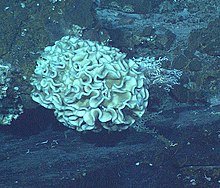This article may be too technical for most readers to understand. Please help improve ittomake it understandable to non-experts, without removing the technical details. (June 2023) (Learn how and when to remove this message)
|
"Monothalamea" is a grouping of foraminiferans, traditionally consisting of all foraminifera with single-chambered tests. Recent work has shown that the grouping is paraphyletic, and as such does not constitute a natural group; nonetheless, the name "monothalamea" continues to be used by foraminifera workers out of convenience.[4]
| Monothalamea | |
|---|---|

| |
| Image of a deep sea xenophyophore | |
| Scientific classification | |
| Domain: | Eukaryota |
| Clade: | Diaphoretickes |
| Clade: | SAR |
| Phylum: | Retaria |
| Subphylum: | Foraminifera |
| Class: | Monothalamea Haeckel, 1862,[1] emend. Pawlowski et al., 2013[2] |
| Orders and subtaxa incertae sedis[3] | |
| |
"Monothalamea" traditionally contains two groups, neither of which is currently considered to be monophyletic:
Recent molecular evidence has revealed that the deep-sea xenophyophores are in fact agglutinated, single-chambered foraminifera.[5] Molecular evidence has also revealed that the freshwater protist Reticulomyxa is in fact a naked, testless foraminifera, and as such it has been included with "monothalameans" in scientific discussion.[4][6]
A 2013 molecular study using small subunit rDNA concluded that known "monothalameans" made up at least 22 distinct living clades from marine environments with an additional four clades from freshwater eDNA.[4]